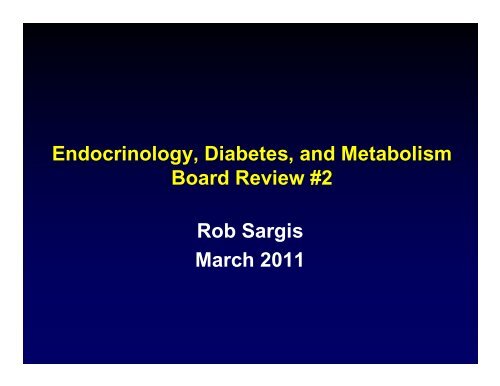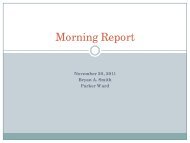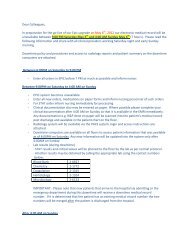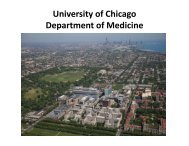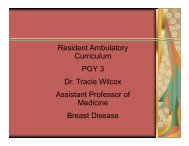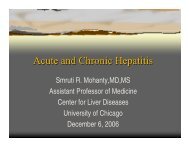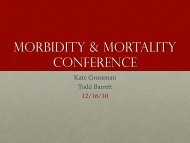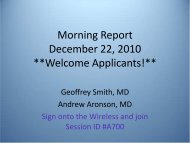Endocrinology, Diabetes, and Metabolism Board Review #2 Rob ...
Endocrinology, Diabetes, and Metabolism Board Review #2 Rob ...
Endocrinology, Diabetes, and Metabolism Board Review #2 Rob ...
You also want an ePaper? Increase the reach of your titles
YUMPU automatically turns print PDFs into web optimized ePapers that Google loves.
<strong>Endocrinology</strong>, <strong>Diabetes</strong>, <strong>and</strong> <strong>Metabolism</strong><br />
<strong>Board</strong> <strong>Review</strong> <strong>#2</strong><br />
<strong>Rob</strong> Sargis<br />
March 2011
• Hypothalamic<br />
• Pit Pituitary it<br />
• Adrenal<br />
• Reproduction<br />
Topics of the Day
Rules of the Game<br />
• I’m Im not going to call on anyone. anyone<br />
• BBut… t<br />
• You have to raise your h<strong>and</strong> to commit<br />
to an answer.
9<br />
• A 25-year-old man is evaluated for a 2-year history of infertility. He <strong>and</strong><br />
his wife have been unable to conceive since marrying 2 years ago. ago<br />
Analysis of a semen sample provided 3 weeks ago during an infertility<br />
evaluation showed azoospermia. The patient has a strong libido <strong>and</strong><br />
no history of erectile dysfunction. He has no other medical problems<br />
<strong>and</strong> exercises regularly. g y There is no family y history y of delayed y ppuberty y<br />
or endocrine tumors.<br />
• On physical examination, the patient appears very muscular.<br />
Temperature is normal, blood pressure is 142/85 mm Hg, pulse rate is<br />
55/min, respiration rate is 14/min, <strong>and</strong> BMI is 22. Visual fields are full to<br />
confrontation. f t ti There Th is i extensive t i acne but b t no gynecomastia ti or<br />
galactorrhea. Testes volume is 4 mL (normal, 18-25 mL) bilaterally. The<br />
penis appears normal.<br />
• Laboratory studies:<br />
– FFollicle-stimulating lli l ti l ti hormone h
• Which of the following is the most<br />
likely diagnosis?<br />
• AA. Anabolic steroid abuse<br />
• B. Nonfunctioning pituitary<br />
macroadenoma d<br />
• C. Primary testicular failure<br />
• D. Prolactinoma
• Which of the following is the most<br />
likely diagnosis?<br />
• AA. Anabolic steroid abuse<br />
• B. Nonfunctioning pituitary<br />
macroadenoma d<br />
• C. Primary testicular failure<br />
• D. Prolactinoma
12<br />
• A 60-year-old-woman is evaluated for headache <strong>and</strong> aching pain in her<br />
hips <strong>and</strong> knees that has gradually become more severe over the past 3<br />
years. She reports that she has had to increase her shoe size twice<br />
over the past 2 years. The patient takes no medications.<br />
• On physical examination, blood pressure is 142/90 mm Hg, pulse rate<br />
is 76/min, respiration rate is 16/min, <strong>and</strong> BMI is 25. Other findings<br />
include an unusually prominent forehead, a heavy brow ridge, a broad<br />
nose, accentuated nasolabial folds, a large tongue, <strong>and</strong> large, thick<br />
h<strong>and</strong>s <strong>and</strong> feet.<br />
• Laboratory y studies show a<br />
– serum growth hormone (GH) level of 18.7 ng/mL (18.7 µg/L)<br />
– insulin-like growth factor 1 (IGF-1) level of 543 ng/mL (543 µg/L) (normal<br />
range, 190-300 ng/mL [190-300 µg/L]).<br />
• An MRI shows a 1.7-cm pituitary p y tumor with minimal parasellar p<br />
extension.<br />
• The patient undergoes transsphenoidal surgery, after which<br />
– GH level remains mildly elevated at 4.2 ng/mL (4.2 µg/L)<br />
– IGF-1 level remains elevated at 402 ng/mL g (402 ( µg/L). µg )
• Which of the following additional<br />
therapies is most likely to normalize<br />
her GH <strong>and</strong> IGF-1 levels over the next<br />
year?<br />
AA. Cabergoline<br />
B. Craniotomy<br />
C. Radiation therapy<br />
D. Somatostatin analogue g
• Which of the following additional<br />
therapies is most likely to normalize<br />
her GH <strong>and</strong> IGF-1 levels over the next<br />
year?<br />
AA. Cabergoline<br />
B. Craniotomy<br />
C. Radiation therapy<br />
D. Somatostatin analogue g
13<br />
• A 21-year-old woman is evaluated for a 7-year history of oligomenorrhea <strong>and</strong><br />
slowly progressive hirsutism hirsutism. Menses began at age 14 years <strong>and</strong> were always<br />
irregular. She has gained weight at a rate of approximately 4.5 kg (10 lb) per<br />
year. Her facial hair has become progressively thicker since age 18 years, <strong>and</strong><br />
she now menstruates only three to four times per year. She is sexually active<br />
but does not want to become pregnant at this time. Family history is<br />
noncontributory, <strong>and</strong> she takes no medications.<br />
• On physical examination, vital signs are normal, <strong>and</strong> BMI is 28. Prominent<br />
terminal hairs are noted on the upper lip <strong>and</strong> chin, with some on the upper<br />
cheeks <strong>and</strong> chest; there is thick hair from the pubis to the umbilicus. Results of<br />
a pelvic examination <strong>and</strong> Pap smear are normal.<br />
• LLaboratory b t studies: t di<br />
– Dehydroepi<strong>and</strong>rosterone sulfate 4.3 µg/mL (11.6 µmol/L)<br />
– Human chorionic gonadotropin Negative for pregnancy<br />
– 17-Hydroxyprogesterone 105 ng/dL (3.15 nmol/L) (normal,
• Which of the following is the most<br />
appropriate next step in<br />
management? g<br />
A. Measurement of free testosterone<br />
level<br />
B. Prednisone therapy<br />
C. Spironolactone <strong>and</strong> oral contraceptive<br />
therapy<br />
D. Transvaginal ovarian ultrasonography
• Which of the following is the most<br />
appropriate next step in<br />
management? g<br />
A. Measurement of free testosterone<br />
level<br />
B. Prednisone therapy<br />
C. Spironolactone <strong>and</strong> oral contraceptive<br />
therapy<br />
D. Transvaginal ovarian ultrasonography
15<br />
• A 65-year-old woman is seen in the office after a CT<br />
scan obtained bt i d in i the th emergency department d t t for f<br />
suspected renal colic incidentally revealed an<br />
adrenal nodule.<br />
• OOn physical h i l examination, i ti temperature t t is i 36.5 36 5 °C<br />
(97.7 °F), blood pressure is 128/74 mm Hg, pulse rate<br />
is 88/min, respiration rate is 16/min, <strong>and</strong> BMI is 30.<br />
All other examination findings are normal. normal There is<br />
no evidence of masculinization.<br />
• The previously obtained CT scan of the abdomen<br />
reveals a 22.5 5-cm cm right adrenal mass with an<br />
attenuation value of 10 Hounsfield units; the liver<br />
<strong>and</strong> kidneys appear normal. Findings on a chest<br />
radiograph g p<br />
are also normal.
• In addition to an overnight g 1-mg g dexamethasone<br />
suppression test, which of the following is the most<br />
reasonable next step in the evaluation of this<br />
patient? p<br />
A. Determination of the serum aldosterone to plasma<br />
renin activity ratio<br />
BB. Determination of the serum aldosterone to plasma<br />
renin activity ratio <strong>and</strong> measurement of plasma<br />
dehydroepi<strong>and</strong>rosterone sulfate level<br />
CC. MMeasurement t of f morning i serum cortisol ti l <strong>and</strong> d<br />
plasma dehydroepi<strong>and</strong>rosterone sulfate levels<br />
D. Measurement of plasma p metanephrine p<br />
level
• In addition to an overnight g 1-mg g dexamethasone<br />
suppression test, which of the following is the most<br />
reasonable next step in the evaluation of this<br />
patient? p<br />
A. Determination of the serum aldosterone to plasma<br />
renin activity ratio<br />
BB. Determination of the serum aldosterone to plasma<br />
renin activity ratio <strong>and</strong> measurement of plasma<br />
dehydroepi<strong>and</strong>rosterone sulfate level<br />
CC. MMeasurement t of f morning i serum cortisol ti l <strong>and</strong> d<br />
plasma dehydroepi<strong>and</strong>rosterone sulfate levels<br />
D. Measurement of plasma p metanephrine p<br />
level
20<br />
• A 55-year-old y man with recently y diagnosed g<br />
pheochromocytoma is evaluated prior to surgical<br />
removal in 10 days. His only medication is<br />
amlodipine. p<br />
• On physical examination, the patient appears<br />
anxious. Temperature is 36.0 °C (96.8 °F), blood<br />
pressure is 172/96 mm Hg, pulse rate is 98/min,<br />
respiration rate is 16/min, <strong>and</strong> BMI is 23. Results of<br />
funduscopic, cardiovascular, <strong>and</strong> neurologic<br />
examinations are normal. normal<br />
• An electrocardiogram shows sinus rhythm at a rate<br />
of 100/min. There is no evidence of ischemia.
• Which of the following is the most<br />
appropriate next step in management?<br />
A. Add chlorthalidone<br />
B. Add metoprolol<br />
C. Add prazosin<br />
D. Hospitalize <strong>and</strong> begin intravenous<br />
phentolamine<br />
p e to a e<br />
E. Hospitalize <strong>and</strong> begin intravenous sodium<br />
nitroprusside p
• Which of the following is the most<br />
appropriate next step in management?<br />
A. Add chlorthalidone<br />
B. Add metoprolol<br />
C. Add prazosin<br />
D. Hospitalize <strong>and</strong> begin intravenous<br />
phentolamine<br />
p e to a e<br />
E. Hospitalize <strong>and</strong> begin intravenous sodium<br />
nitroprusside p
22<br />
• A 28-year-old woman is evaluated for a 2-year history of<br />
infertility <strong>and</strong> a 44-year year history of amenorrhea <strong>and</strong> galactorrhea<br />
galactorrhea.<br />
She has no other relevant personal or family medical history<br />
<strong>and</strong> takes no medications.<br />
• On physical examination, vital signs are normal. Bilateral<br />
expressible ibl galactorrhea l t h is i noted. t d<br />
• Results of laboratory studies are normal except for a serum<br />
prolactin level of 239 ng/mL (239 µg/L).<br />
• An MRI of the pituitary gl<strong>and</strong> shows a 11.4-cm 4-cm hypodense lesion<br />
compatible with a macroadenoma.<br />
• She is treated with cabergoline, <strong>and</strong> her prolactin level returns<br />
to the normal range. A repeat MRI shows that the tumor had<br />
decreased to 7 mm in maximum diameter. diameter She calls 1 week<br />
later after she learns that she is approximately 2 months<br />
pregnant; she has discontinued taking cabergoline.
• The patient should be counseled<br />
about which of the following potential<br />
complications p related to her<br />
prolactinoma?<br />
A. Fetal malformation<br />
B. Premature delivery<br />
C. Prolactinoma enlargement<br />
D. Sheehan syndrome<br />
EE. Stillbirth
• The patient should be counseled<br />
about which of the following potential<br />
complications p related to her<br />
prolactinoma?<br />
A. Fetal malformation<br />
B. Premature delivery<br />
C. Prolactinoma enlargement<br />
D. Sheehan syndrome<br />
EE. Stillbirth
30% of macroprolactinomas<br />
3% of microprolactinomas
27<br />
• A 45-year-old woman is evaluated for a 6-month history of<br />
weakness weakness, menstrual irregularities, irregularities hirsutism, hirsutism insomnia insomnia, <strong>and</strong><br />
emotional lability. She also reports an 8.0-kg (17.6-lb) weight<br />
gain during this period. She was previously healthy. She takes<br />
no medications.<br />
• OOn physical h i l examination, i ti temperature t t is i 36.0 36 0 °C (968°F) (96.8 °F), blood bl d<br />
pressure is 172/90 mm Hg, pulse rate is 78/min, respiration rate<br />
is 16/min, <strong>and</strong> BMI is 32. The patient has a rounded, plethoric<br />
face with increased supraclavicular <strong>and</strong> dorsal fat pads. There<br />
are areas of f unexplained l i d ecchymoses h over the th upper <strong>and</strong> d lower l<br />
extremities. Abdominal examination reveals purple striae. She<br />
has proximal muscle weakness.<br />
• Results of routine laboratory y studies are normal except p for a<br />
serum potassium level of 3.4 meq/L (3.4 mmol/L).
• Which of the following is the most<br />
appropriate next test for this patient?<br />
A. Cosyntropin stimulation test<br />
B. High-dose dexamethasone<br />
suppression test<br />
C. Measurement of morning serum<br />
cortisol level<br />
D. Measurement of 24-hour urine free<br />
cortisol excretion
• Which of the following is the most<br />
appropriate next test for this patient?<br />
A. Cosyntropin stimulation test<br />
B. High-dose dexamethasone<br />
suppression test<br />
C. Measurement of morning serum<br />
cortisol level<br />
D. Measurement of 24-hour urine free<br />
cortisol excretion
29<br />
• A 24-year-old woman is evaluated for a 5-week history of polyuria <strong>and</strong><br />
polydipsia (both of which were of sudden onset), onset) a 3-month history of<br />
mild fatigue, a 7-month history of galactorrhea, <strong>and</strong> a 1-year history of<br />
secondary amenorrhea. She has been drinking between 7.5 <strong>and</strong> 9.5<br />
liters of water daily <strong>and</strong> has been awakening three to five times per<br />
night g to urinate; ; she is always y thirsty y at these times. The ppatient<br />
reports normal growth <strong>and</strong> development; she experienced menarche<br />
at age 12 years. Approximately 6 months ago, her ophthalmologist<br />
diagnosed uveitis. She takes no medications.<br />
• Physical examination reveals a short, mildly overweight woman. Blood<br />
pressure iis 118/74 mm Hg, H pulse l rate t is i 78/min, 78/ i <strong>and</strong> d BMI is i 27.1. 27 1<br />
Bilateral expressible galactorrhea <strong>and</strong> axillary lymphadenopathy are<br />
noted. Breast development <strong>and</strong> pubic hair are normal.<br />
• Laboratory studies:<br />
– SSodium di 146 meq/L /L (146 mmol/L) l/L)<br />
– Osmolality: Plasma 305 mosm/kg; Urine 84 mosm/kg<br />
– Prolactin 48.2 ng/mL (48.2 µg/L)<br />
– Thyroxine (T4), free 1.2 ng/dL (15.5 pmol/L)<br />
– AAn MRI shows h a normal l pituitary it it gl<strong>and</strong> l d but b t a thickened thi k d pituitary it it stalk.<br />
t lk
• Which of the following is the best next<br />
step in diagnosis?<br />
AA. Biopsy of the stalk lesion<br />
B. Chest radiography<br />
C. Inferior petrosal sinus sampling<br />
D. Measurement of anti–single-str<strong>and</strong>ed<br />
g<br />
DNA antibodies
• Which of the following is the best next<br />
step in diagnosis?<br />
AA. Biopsy of the stalk lesion<br />
B. Chest radiography<br />
C. Inferior petrosal sinus sampling<br />
D. Measurement of anti–single-str<strong>and</strong>ed<br />
g<br />
DNA antibodies
34<br />
• A 34-year-old man is evaluated for a 1-year history of impotence. He<br />
reports mild fatigue but no headaches or visual symptoms. symptoms Personal<br />
<strong>and</strong> family medical histories are noncontributory. He takes no<br />
medications.<br />
• Physical examination reveals an obese man. Blood pressure in 132/80<br />
mm Hg, pulse rate is 80/min, respiration rate is 16/min, <strong>and</strong> BMI is 32.3.<br />
He has normal secondary sexual characteristics.<br />
• Laboratory studies:<br />
– Prolactin 11,420 ng/mL (11,420 µg/L)<br />
– Testosterone 134 ng/dL (4.6 (4 6 nmol/L)<br />
– Thyroid-stimulating hormone 0.6 µU/mL (0.6 mU/L)<br />
– Thyroxine (T4), free 0.52 ng/dL (6.7 pmol/L)<br />
– Cortisol (8 AM) 4.3 µg/dL (118.7 nmol/L) (normal range, 5-25 µg/dL [138-690<br />
nmol/L]) ])<br />
– An MRI shows a 3.2- × 1.7- × 2.8-cm macroadenoma invading the<br />
cavernous sinus <strong>and</strong> wrapping around the right carotid artery. Results of<br />
visual field testing are normal.
• In addition to treating the<br />
hypopituitarism, which of the<br />
following g is the most appropriate pp p<br />
initial therapy for this patient?<br />
A. Cabergoline g<br />
B. Pituitary surgery via a craniotomy<br />
C. Radiation therapy<br />
D. Somatostatin analogue<br />
EE. Transsphenoidal surgery
• In addition to treating the<br />
hypopituitarism, which of the<br />
following g is the most appropriate pp p<br />
initial therapy for this patient?<br />
A. Cabergoline g<br />
B. Pituitary surgery via a craniotomy<br />
C. Radiation therapy<br />
D. Somatostatin analogue<br />
EE. Transsphenoidal surgery
39<br />
• A 32-year-old man is evaluated for a 5-month history of poor libido, constant<br />
fatigue fatigue, <strong>and</strong> erectile dysfunction dysfunction. The patient has chronic pain from a motor<br />
vehicle accident 3 years ago in which he sustained back trauma. Although the<br />
pain is largely controlled with sustained-release oral morphine <strong>and</strong> his<br />
functional status is good, his quality of life is poor because of the fatigue <strong>and</strong><br />
lack of sex drive. He takes no other medications.<br />
• On physical examination, examination vital signs are normal, normal <strong>and</strong> BMI is 35. 35 Visual fields are<br />
full to confrontation. There is no gynecomastia. Testes volume is 15 mL<br />
(normal, 18–25 mL) bilaterally. The penis appears normal.<br />
• Laboratory studies:<br />
– Cortisol (8 AM) 20 µg/dL (552 nmol/L) (normal range, 5-25 µg/dL [138-690 nmol/L])<br />
– Follicle-stimulating hormone 0.2 mU/mL (0.2 U/L)<br />
– Insulin-like growth factor 1 Normal<br />
– Luteinizing hormone 0.1 mU/ml (0.1 U/L)<br />
– Prolactin 12 ng/mL (12 µg/L)<br />
– Sex hormone binding globulin Normal<br />
– Testosterone, total 167 ng/dL (5.8 nmol/L)<br />
– Thyroid-stimulating hormone 1.6 µU/mL (1.6 mU/L)<br />
– Thyroxine (T4), free 1.7 ng/dL (21.9 pmol/L)<br />
– An MRI of the pituitary gl<strong>and</strong> shows normal findings.
• Which of the following is the most<br />
likely diagnosis?<br />
AA. Anabolic steroid abuse<br />
B. Opioid-induced hypogonadism<br />
C. Primary hypogonadism<br />
D. Normal gonadal g<br />
function
• Which of the following is the most<br />
likely diagnosis?<br />
AA. Anabolic steroid abuse<br />
B. Opioid-induced hypogonadism<br />
C. Primary hypogonadism<br />
D. Normal gonadal g<br />
function
44<br />
• A 55-year-old man is evaluated for a 5-year history of progressively<br />
increasing fatigue <strong>and</strong> loss of energy. energy He has had a 66.8-kg 8-kg (15-lb)<br />
weight gain during this period. He reports decreased libido,<br />
occasional erectile dysfunction, <strong>and</strong> daytime somnolence. He says his<br />
wife has told him that he snores during the night. Type 2 diabetes<br />
mellitus was diagnosed g last year. y Current medications are metformin<br />
<strong>and</strong> glipizide.<br />
• On physical examination, vital signs are normal, <strong>and</strong> BMI is 27. There<br />
is normal beard growth <strong>and</strong> no gynecomastia. Testes volume is 18 mL<br />
(normal, 18-25 mL) bilaterally. The penis appears normal.<br />
• Laboratory studies:<br />
– Follicle-stimulating hormone 2 mU/mL (2 U/L)<br />
– Luteinizing hormone 3 mU/mL (3 U/L)<br />
– Prolactin10 ng/mL g (10 ( µg/L) g )<br />
– Testosterone, total160 ng/dL (5.6 nmol/L)<br />
– Thyroid-stimulating hormone1.7 µU/mL (1.7 mU/L)<br />
– Thyroxine (T4), free 1.0 ng/dL (12.9 pmol/L)<br />
– An MRI of the pituitary gl<strong>and</strong> shows normal findings.
• Which of the following is the best next<br />
step in management?<br />
AA. Sleep study<br />
B. Testosterone replacement therapy<br />
C. Vardenafil treatment<br />
D. Visual field testing<br />
E. Reassurance
• Which of the following is the best next<br />
step in management?<br />
AA. Sleep study<br />
B. Testosterone replacement therapy<br />
C. Vardenafil treatment<br />
D. Visual field testing<br />
E. Reassurance
48<br />
• A 34-year-old y woman is seen for follow-up p after results<br />
of laboratory studies confirm hypercortisolism.<br />
• Laboratory studies:<br />
– Adrenocorticotropic hormone 50 pg/mL (11 pmol/L)<br />
– Urine free cortisol 288 µg/24 h (793.6 nmol/24 h)<br />
– Cortisol (8 AM)<br />
• After 1 mg of dexamethasone the night before 12 12.9 9 µg/dL (356 (356.0 0<br />
nmol/L) (normal,
• Which of the following is the most<br />
appropriate next diagnostic test?<br />
AA. Cosyntropin stimulation test<br />
B. Inferior petrosal sinus catheterization<br />
<strong>and</strong> d sampling li<br />
C. Positron-emission tomography<br />
D. Selective bilateral adrenal vein<br />
catheterization
• Which of the following is the most<br />
appropriate next diagnostic test?<br />
AA. Cosyntropin stimulation test<br />
B. Inferior petrosal sinus catheterization<br />
<strong>and</strong> d sampling li<br />
C. Positron-emission tomography<br />
D. Selective bilateral adrenal vein<br />
catheterization
58<br />
• A pregnant 23-year-old woman is evaluated in the office for a 3-week history of<br />
progressive generalized headaches <strong>and</strong> severe progressive weakness weakness. She is<br />
at 30 weeks’ gestation <strong>and</strong> has lost 0.9 kg (2.0 lb) over the past month. She has<br />
a history of Hashimoto disease with hypothyroidism <strong>and</strong> no history of irregular<br />
menses. Current medications include levothyroxine, 112 µg/d, <strong>and</strong> prenatal<br />
vitamins.<br />
• Physical examination reveals a clinically euthyroid woman. woman Blood pressure is<br />
92/60 mm Hg, pulse rate is 92/min, <strong>and</strong> BMI is 24.9. Her thyroid is mildly<br />
enlarged <strong>and</strong> firm. Other physical examination findings, including results of<br />
visual field testing <strong>and</strong> funduscopic examination, are normal. Neurologic<br />
examination findings are also normal.<br />
• LLaboratory b t studies: t di<br />
– Adrenocorticotropic hormone
• Which of the following is the most<br />
likely diagnosis?<br />
AA. Craniopharyngioma<br />
B. Lymphocytic hypophysitis<br />
C. Pituitary tumor apoplexy<br />
D. Prolactinoma
• Which of the following is the most<br />
likely diagnosis?<br />
AA. Craniopharyngioma<br />
B. Lymphocytic hypophysitis<br />
C. Pituitary tumor apoplexy<br />
D. Prolactinoma
61<br />
• A 34-year-old woman is evaluated for a 6-month history of rapidly<br />
progressive hirsutism hirsutism, a 3-month history of acne <strong>and</strong> weight gain gain, <strong>and</strong><br />
a 2-month history of irregular menses. She also notes that her voice<br />
has deepened over the past month. The patient has not menstruated<br />
for the past 2 months despite having normal menses previously.<br />
Family y history y is unremarkable. She takes no medications.<br />
• On physical examination, vital signs are normal, <strong>and</strong> BMI is 26. There<br />
are coarse hairs on the upper <strong>and</strong> lower lips, chin, <strong>and</strong> sides of her<br />
face. Acne is present on her face <strong>and</strong> back. She has no galactorrhea.<br />
Pelvic examination reveals an enlarged clitoris.<br />
• Laboratory studies:<br />
– Follicle-stimulating hormone 2 mU/mL (2 U/L)<br />
– Human chorionic gonadotropin Negative<br />
– Luteinizing g hormone 1.2 mU/mL (1.2 ( U/L) )<br />
– Prolactin 17 ng/mL (17 µg/L)<br />
– Testosterone, total 326 ng/dL (11.3 nmol/L)<br />
– Thyroid-stimulating hormone 1.1 µU/mL (1.1 mU/L)
• Which of the following is the most<br />
appropriate next diagnostic test?<br />
AA. CT of the abdomen <strong>and</strong> pelvis<br />
B. Measurement of the serum estradiol<br />
llevell C. Measurement of the serum free<br />
testosterone level<br />
D. Progestin g withdrawal challenge g
• Which of the following is the most<br />
appropriate next diagnostic test?<br />
AA. CT of the abdomen <strong>and</strong> pelvis<br />
B. Measurement of the serum estradiol<br />
llevell C. Measurement of the serum free<br />
testosterone level<br />
D. Progestin g withdrawal challenge g
65<br />
• A 56-year-old man is evaluated in the office for a persistent headache<br />
that began 1 week ago when he struck his head in a fall from a ladder ladder.<br />
A CT scan obtained in the emergency department at that time showed<br />
no subdural hematoma but did show a pituitary adenoma. A<br />
subsequent MRI confirmed a 1.1-cm hypodense area in the pituitary<br />
that was compatible p with a pituitary p y adenoma <strong>and</strong> did not abut the<br />
optic chiasm. He has had no symptoms compatible with Cushing<br />
syndrome or acromegaly <strong>and</strong> has normal sexual function. He takes no<br />
medications.<br />
• On physical examination, blood pressure is 128/74 mm Hg, pulse rate<br />
iis 76/min, 76/ i respiration i ti rate t is i 14/min, 14/ i <strong>and</strong> d BMI is i 25.3. 25 3 There Th is i no<br />
clinical evidence of either Cushing syndrome or acromegaly. The<br />
patient has normal secondary sexual characteristics.<br />
• Laboratory studies:<br />
– IInsulin-like li lik growth th ffactor t 1 383 ng/mL / L (383 µg/L) /L) (normal ( l for f age) )<br />
– Prolactin13.2 ng/mL (13.2 µg/L)<br />
– Testosterone 485 ng/dL (16.8 nmol/L)<br />
– Thyroxine (T4), free 1.2 ng/dL (15.5 pmol/L)
• Which of the following is the most<br />
appropriate management of his<br />
pituitary adenoma?<br />
A. Gamma knife irradiation<br />
BB. IInitiation iti ti of f cabergoline b li<br />
C. Initiation of a somatostatin analogue<br />
D. Repeat MRI in 1 year<br />
EE. Transsphenoidal surgery
• Which of the following is the most<br />
appropriate management of his<br />
pituitary adenoma?<br />
A. Gamma knife irradiation<br />
BB. IInitiation iti ti of f cabergoline b li<br />
C. Initiation of a somatostatin analogue<br />
D. Repeat MRI in 1 year<br />
EE. Transsphenoidal surgery
78<br />
• A 55-year-old man is evaluated for new-onset type 2 diabetes mellitus. The<br />
patient also reports a chronic productive cough <strong>and</strong> poor exercise tolerance tolerance.<br />
Six months ago, he had normal results on physical examination <strong>and</strong> normal<br />
laboratory values, including glucose, lipids, <strong>and</strong> electrolytes. He has a 40-packyear<br />
smoking history. There is no pertinent family history. The patient takes no<br />
medications.<br />
• On physical examination, examination temperature is 36.5 36 5 °C C (977°F) (97.7 F), blood pressure is<br />
172/92 mm Hg, pulse rate is 90/min, respiration rate is 21/min, <strong>and</strong> BMI is 24.5.<br />
Mucous membranes <strong>and</strong> nail beds are hyperpigmented. There is temporal<br />
muscle wasting <strong>and</strong> proximal muscle weakness in the upper <strong>and</strong> lower<br />
extremities. He does not have a dorsal fat pad, moon facies, or purple striae.<br />
• LLaboratory b t studies: t di<br />
– Electrolytes:<br />
• Sodium 146 meq/L (146 mmol/L)<br />
• Potassium 2.4 meq/L (2.4 mmol/L)<br />
• Chloride 101 meq/L (101 mmol/L)<br />
• Bi Bicarbonate b t 33 meq/L /L (33 mmol/L) l/L)<br />
– Adrenocorticotropic hormone (ACTH) 365 pg/mL (80.3 pmol/L)<br />
– Cortisol (8 AM) 58 µg/dL (1601 nmol/L) (normal range, 5-25 µg/dL [138-690 nmol/L])
• Which of the following is the most<br />
likely cause of this patient’s findings?<br />
AA. Adrenal adenoma<br />
B. Adrenal carcinoma<br />
C. Cushing disease<br />
D. Ectopic p<br />
ACTH secretion
• Which of the following is the most<br />
likely cause of this patient’s findings?<br />
AA. Adrenal adenoma<br />
B. Adrenal carcinoma<br />
C. Cushing disease<br />
D. Ectopic p<br />
ACTH secretion
87<br />
• A 62-year-old man is evaluated after an adrenal mass is found on a CT<br />
scan of the abdomen. The scan was obtained during the evaluation of<br />
abdominal pain p of 1 week’s duration; ; the pain p has since subsided, , <strong>and</strong><br />
he has had no other symptoms. The patient reports feeling healthy.<br />
Personal <strong>and</strong> family medical history is noncontributory. He takes no<br />
medications.<br />
• On physical examination, vital signs <strong>and</strong> results of the general<br />
physical h i l examination i i are normal. l<br />
• Laboratory studies:<br />
– Electrolytes:<br />
• Sodium 139 meq/L (139 mmol/L)<br />
• Potassium 4.1 meq/L (4.1 mmol/L)<br />
• Chloride 97 meq/L (97 mmol/L)<br />
• Bicarbonate 29 meq/L (29 mmol/L)<br />
– Cortisol<br />
• (8 AM) Initial measurement 13 13.8 8 µg/dL (380 (380.9 9 nmol/L) (normal (normal, 5-25 µg/dL [138-690<br />
nmol/L])<br />
• After 1 mg of dexamethasone the night before 1.1 µg/dL (30.4 nmol/L) (normal,
• Which of the following is the most<br />
appropriate next step in<br />
management?<br />
A. Metaiodobenzylguanidine (MIBG) scan<br />
BB. PPositron it emission i i tomography<br />
t h<br />
C. Repeat testing in 12 months<br />
D. Right adrenalectomy
• Which of the following is the most<br />
appropriate next step in<br />
management?<br />
A. Metaiodobenzylguanidine (MIBG) scan<br />
BB. PPositron it emission i i tomography<br />
t h<br />
C. Repeat testing in 12 months<br />
D. Right adrenalectomy
91<br />
• A 28-year-old woman is evaluated in the office for a 3-year<br />
history of amenorrhea amenorrhea. The patient has been otherwise healthy healthy.<br />
She is sexually active <strong>and</strong> is not interested in becoming<br />
pregnant in the near future. Her personal <strong>and</strong> family medical<br />
histories are noncontributory. She takes no medications.<br />
• EExamination i ti reveals l normal l vital it l signs; i BMI is i 24. 24 No N<br />
galactorrhea is detected. Findings from the remainder of the<br />
examination, including visual field testing by confrontation, are<br />
normal.<br />
• Laboratory studies<br />
– Serum prolactin level of 48.3 ng/mL (48.3 µg/L).<br />
– Results of thyroid, adrenal, <strong>and</strong> hepatic function testing are<br />
normal, <strong>and</strong> a pregnancy test is negative.<br />
• An MRI shows a 4-mm hypointense area in the pituitary gl<strong>and</strong><br />
that is compatible with a microadenoma.
• Which of the following is the most<br />
appropriate next step in<br />
management?<br />
A. Bromocriptine<br />
BB. OOral l contraceptives<br />
t ti<br />
C. Stereotactic radiation therapy<br />
D. Transsphenoidal surgery<br />
EE. Reassurance
• Which of the following is the most<br />
appropriate next step in<br />
management?<br />
A. Bromocriptine<br />
BB. OOral l contraceptives<br />
t ti<br />
C. Stereotactic radiation therapy<br />
D. Transsphenoidal surgery<br />
EE. Reassurance


